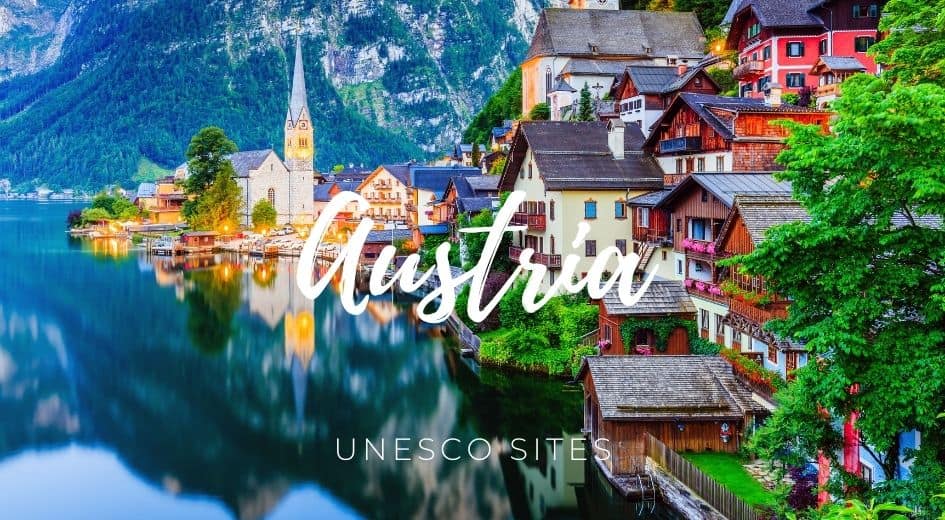Table of Contents


Austria UNESCO has registered 12 sites on the World Heritage list and 10 on the tentative list.
Some places are so interesting that it’s relevant to keep them for future generations. This is why UNESCO has built a list of crucial classified properties in which superb places stand out for their aesthetic, natural, artistic, or cultural significance.
More than a thousand places are registered as Unesco’s World Heritage worldwide. Due to my interest in visiting World Heritage sites, I compiled the UNESCO list in Austria and the corresponding map.
Austria UNESCO list
- City of Graz – Historic Centre and Schloss Eggenberg
- Fertö / Neusiedlersee Cultural Landscape
- Frontiers of the Roman Empire – The Danube Limes (Western Segment)
- Hallstatt-Dachstein / Salzkammergut Cultural Landscape
- Historic Centre of the City of Salzburg
- Historic Centre of Vienna
- Palace and Gardens of Schönbrunn
- Prehistoric Pile Dwellings around the Alps
- Semmering Railway
- The Great Spa Towns of Europe
- Wachau Cultural Landscape
- Ancient and Primeval Beech Forests of the Carpathians and Other Regions of Europe
Austria UNESCO Map
Click on the blue pins to view more relevant information about each World Heritage site in Austria.
Description
- City of Graz – Historic Centre and Schloss Eggenberg: is a Site in Graz, Austria. It is known for its well-preserved historic center, which reflects the city’s cultural and architectural heritage, and Schloss Eggenberg, a Baroque palace and park on its outskirts.
- Fertö / Neusiedlersee Cultural Landscape: is between Austria and Hungary. It is known for its well-preserved cultural and natural landscape, including the unique salt pans of the Neusiedlersee and the Fertö Lake, home to a diverse array of plant and animal species.
- Frontiers of the Roman Empire – The Danube Limes (Western Segment): has several Roman archaeological sites along the Danube River in Austria. It is known for its well-preserved fortifications, settlements, and other structures that reflect the Roman presence in the region.
- Hallstatt-Dachstein / Salzkammergut Cultural Landscape: is a Site in Austria. It is known for its well-preserved cultural and natural landscape, including the historic town of Hallstatt and the surrounding mountains and lakes, which have been an important source of salt since prehistoric times.
- Historic Centre of the City of Salzburg: is in Salzburg, Austria. It is known for its well-preserved historic center, which includes numerous Baroque buildings and monuments associated with the city’s musical heritage, particularly Mozart.
- Historic Centre of Vienna: is a Site in Vienna, Austria. It is known for its well-preserved historical buildings, numerous palaces and churches, and rich cultural and artistic heritage.
- Palace and Gardens of Schönbrunn: are a UNESCO World Heritage Site in Vienna, Austria. It is known for its well-preserved Baroque palace and gardens, a testament to the Habsburg dynasty’s power and influence.
- Prehistoric Pile Dwellings around the Alps: this is a UNESCO World Heritage Site that includes several prehistoric archaeological sites around the Alps in Austria, France, Germany, Italy, Slovenia, and Switzerland. It is known for its well-preserved settlements and artifacts reflecting the region’s early human presence.
- Semmering Railway: Austria’s UNESCO World Heritage Site. It is known for its well-preserved mountain railway, built in the 19th century and considered a masterpiece of civil engineering.
- The Great Spa Towns of Europe: is a UNESCO World Heritage Site with several European spa towns, including Baden bei Wien in Austria, Karlovy Vary in the Czech Republic, and Bath in England.
- Wachau Cultural Landscape: is a UNESCO World Heritage Site in Austria. It is known for its well-preserved cultural and natural landscape, including the historic town of Krems and the surrounding vineyards and orchards cultivated since the Middle Ages.
- The Ancient and Primeval Beech Forests of the Carpathians and Other Regions of Europe is a UNESCO World Heritage Site that includes a network of 78 protected areas in 12 countries across Europe, including Austria, Belgium, Bulgaria, Croatia, Germany, Italy, Romania, Slovakia, Slovenia, Spain, Ukraine, and Albania. It is known for its well-preserved and diverse ecosystem, including beech forests that have been untouched for centuries and provide habitat for numerous plant and animal species. The site also has significant cultural and historical value, as it reflects the long-standing relationship between humans and the natural environment in the region.
UNESCO World Heritage Sites in Austria have protected places for their cultural and natural importance.
Sites on the Tentative List
- Cultural Landscape of “Innsbruck-Nordkette/Karwendel”
- Iron Trail with Erzberg and the old town of Steyr
- Bregenzerwald (Bregenz Forest)
- Abbey of Kremsmünster
- Heiligenkreuz Abbey
- Hochosterwitz Castle
- Cathedral of Gurk
- National Park “Hohe Tauern”
- Hall in Tyrol – The Mint
- Großglockner High Alpine Road / Großglockner Hochalpenstraße


